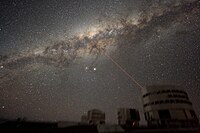
Photo from wikipedia
Dimensions of the edge-lit light guide plate (LGP) have a non-negligible impact on its output performance based on a pre-determined micro-dot array. However, how the LGP's dimension affects the performance… Click to show full abstract
Dimensions of the edge-lit light guide plate (LGP) have a non-negligible impact on its output performance based on a pre-determined micro-dot array. However, how the LGP's dimension affects the performance has not been systematically researched. In this paper, the dimension of the LGP is numerically established as a function to the light output performance, which can be divided into four successive procedures. Firstly, the micro-structural dot array is designed based on the calculated illuminance distribution of the LGP's bottom surface. Based on this, the light energy output can be derived by defining three key parameters, which are dot density, scatting coefficient, and collision loss coefficient. After that, the ray-tracing simulation is used to determine the above parameters. Finally, the optimal dimensions of the LGP can be obtained with a specific correlation function with the light energy output. The mathematical relation above is demonstrated via both simulation and experiment. Our approach provides a systematic design for balancing the efficiency and uniformity of backlight by combining the dot design and the dimensional optimization, which has important theoretical guiding significance for actual display application.
Journal Title: Optics express
Year Published: 2021
Link to full text (if available)
Share on Social Media: Sign Up to like & get
recommendations!